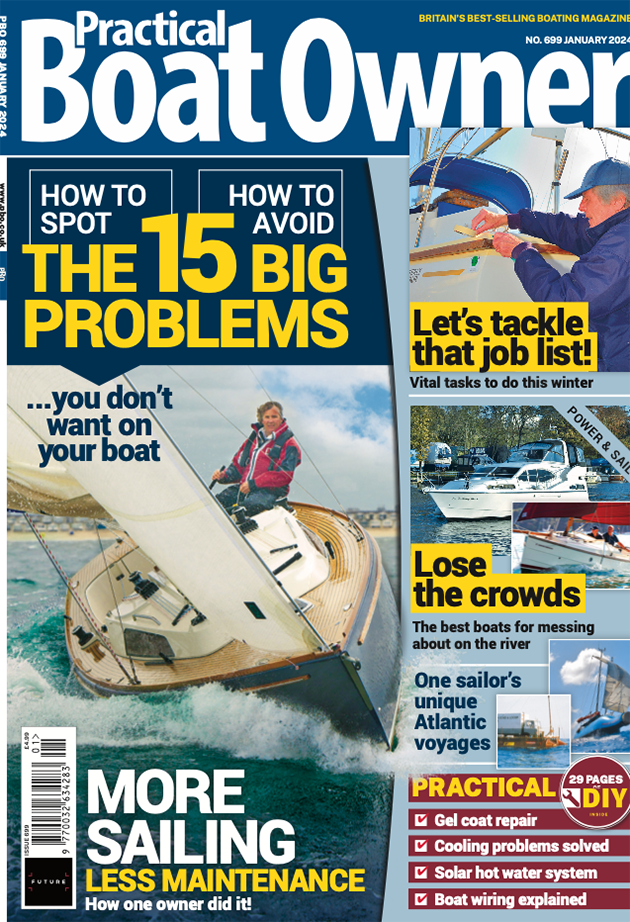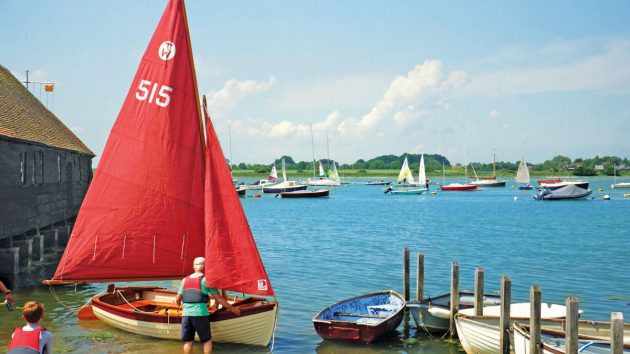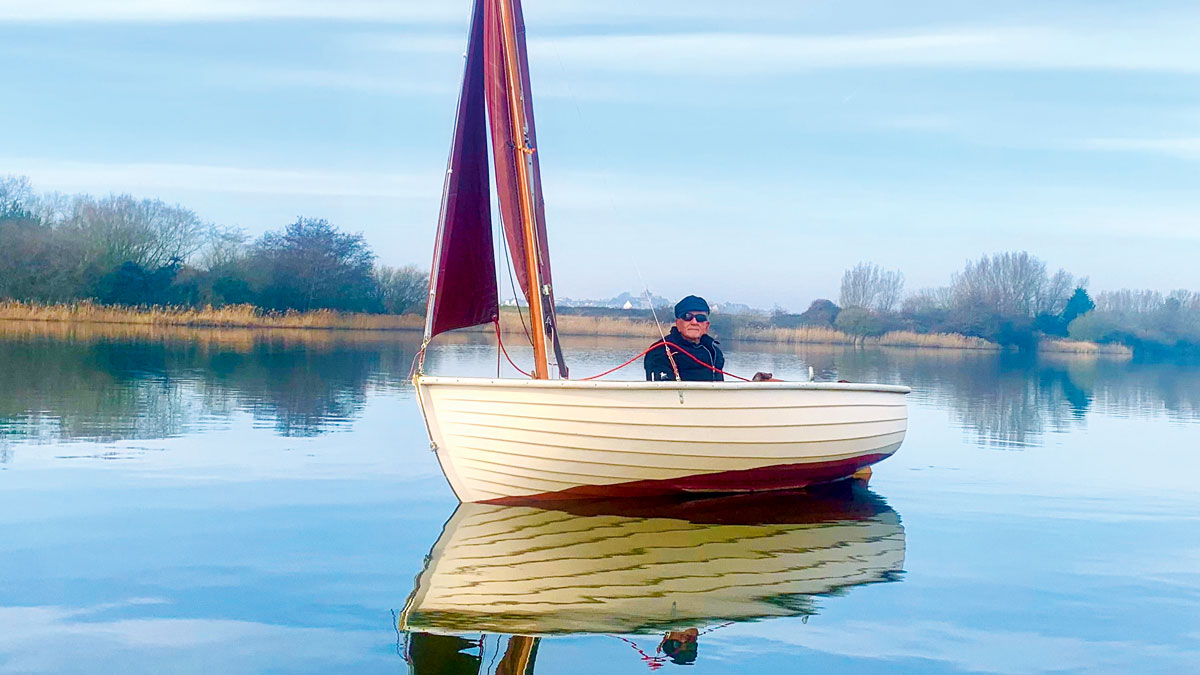Prolific boat owner Clive Marsh extols the virtues of the Tideway 12, which can be launched by hand from a trolley
The Tideway 12 is a marvellous craft.
My Tideway was No.462, a GRP version that was named Jackdaw by a previous owner presumably because she is black.
Calling out her name on the VHF would be a bit of a mouthful – ‘Juliet/Alpha/Charlie/Kilo/Delta/Alpha/Whiskey’… too late!
But I liked the name and kept it. However, if ever I name a boat it is always ‘Tui’ after a little bird that lived in my garden in New Zealand.
Tui is easy to spell out; ‘Tango/Uniform/India’. When naming a boat it’s worth keeping to just a few letters.

Clive Marsh sailing his Tideway 12 Jackdaw
The tui bird was named as such by the Maoris because the sound it makes is ‘too eee’.
Jackdaw’s GRP hull is simulated clinker and she’s very well fitted out.
The wooden mast and spars all fit neatly inside the boat and the gunter rig uses both throat and peak halyards.
The mast steps onto the supported forward thwart and is kept up by a forestay and side shrouds.
With the jib halyard and topping lift, there is a fair amount of rope going up and down the maypole and it is necessary to be organised.
Using different coloured ropes helps.
Mast up and down
When lowering the mast I tend to attach all halyards, the topping lift and forestay to cleats at the base of the mast and lash them to the mast with a single tie.
Keeping the shrouds attached to the chainplates I then lower the mast into the boat.
Once organised the whole operation doesn’t take too long either lowering or stepping the mast.
On balance, I’d prefer less rope and have the mast stepped onto the keelson supported by a gunwale-level thwart, unstayed as it is in my Emsworth Lugger and Smack’s Boat.
This might mean the mast may not fit into the hull when down but this is no a bad thing for if it’s carefully supported fore, aft and midships it would hold up the all-over boat cover and help drainage.

Nice internal fit-out for Clive’s Tideway 12
But this is just a personal preference and I suspect most owners like her just as she is.
Having owned so many boats I’m always tempted to incorporate all the best bits of every boat into one boat which is not always possible in the ‘compromise’ world of boatbuilding
I bought the Tideway 12 because I wanted a seaworthy craft that I could launch by hand from a trolley.
She uses a combination road trailer or trolley and there’s no need ever to immerse the road trailer wheel bearings.
This saves a lot of time when regularly towing a boat to different locations since you don’t need to check the bearings so often.
Continues below…
Cruising dinghies for timeless adventures
Trailer-sailers can be stored at home, may not need a motor and can provide cosy accommodation with clever use of…
Tideway 10: Gunter or Lugger?
The trailerable Tideway 10 has the benefits of her sister vessel, the Tideway 12, but is lighter and easier to…
Drascombe & Devon Lugger vs the Dabber
Designed for safe family boating under sail, or or power, but taken long distance by intrepid sailors, Clive Marsh looks…
Winchelsea Lugger used boat report: A 14ft beach boat that can cross the Channel
Sussex beach boats and their Flobart sisters on the other side of the channel are amongst my favourite luggers. In…
The boat’s hull only weighs around 240lb so is manageable by hand most of the time.
If things get a bit steep then don’t forget that it’s much easier to zigzag up a slipway (using chocks when necessary) than it is to push a boat straight up a slipway.
Alternatively, use a long rope attached to your car or even your trailer’s winch if the trailer is attached to the car.
Pulling a boat out of the water should never be back breaking, it’s always a question of using your brain and not your back.
On a busy slipway, there is a tendency to rush things to get out of other people’s way and this is when you might get carried away and forget to take good care of your back.
Stable design
The original Tideway 12 was designed and built by Lew Walker in 1954 at Leigh-on-Sea in Essex.
In my opinion, he got it just right and has given many sailors and families much pleasure over very many years, a real accomplishment.
It’s often said that the length of a boat should equal a sailor’s age. The basis for this is that as we get older and less agile we need a more comfortable boat.
Well, I’ve found it works the other way, certainly with the Tideway for she is such a comfortable and stable craft.

Clive finds his Tideway 12 is very easy to sail
And in any case, I don’t want the hassle of a 73ft long boat. The Tideway 12 is very easy to sail, predictable and sails close enough to the wind for me.
Since 2003 GRP Tideways have been built by Tideway Dinghies and in 2006 the Tideway Owners’ Association also secured a builder to continue building in wood.
The boats are raced and cruised. But for me, it is all about cruising.
Bosham is a very good place to launch your Tideway 12. There is a slipway, pub, a restaurant and an excellent hotel.
Then you can sail to Itchenor which takes about 30 minutes if the tide is favourable.
At Itchenor there’s another hotel and restaurant. From there you can sail to Dell Quay which has a very good pub and restaurant on the water’s edge.
When tired of this you can sail to East Head and beach your boat on the sands to take a swim. Then on to Emsworth for more restaurants and lots of shops. All this in safe tidal waters.
Versatile craft
There’s a whole new world of places to visit on your doorstep and a little Tideway will take you there with no road traffic and car parking hassle.
You can sail, row or motor a Tideway 12, launch her with ease and drag her up a beach.
She is the ideal cruising dinghy and can be sailed single-handed or with two people, a few kids, a dog or some shopping.
One of the best, but private places to launch from in Chichester Harbour is Cobnor Point (permission only) and once a year the Tideway Owners’ Association holds an annual event for competition and cruising.
None of these things are so easy with a large yacht, particularly one with a fin keel that won’t take the ground. A light lifting keel dinghy is ideal for visiting waterside inns and villages.

The Tideway Owners’ Association holds regular events. Credit: Alamy
One of the best things about owning a Tideway is belonging to the owners’ association.
Events are held throughout the country and this encourages you to sail from many different locations with all the storage and organisational details sorted.
For example, events often include The Broads, Coniston, Menai, Chichester, Falmouth and Poole. At these events, you’ll meet like-minded people and be able to share advice and experiences and make new friends.
I’ve always found that boat ownership is more than just boating, and owning a little Tideway opens up a host of associated activities.
For those who prefer a simpler boat with less string and less weight, there is also a Tideway 10.
This boat has a simple lug sail.
Tideway 12 specifications:
Model: Tideway 12 (GRP model)
Type: Smack’s boat
Length: 12ft (3.66m)
Beam: 5ft (1.52m)
Draught: 3ft (0.91m) with plate down
Sail area: 77.5ft2 (7.2m2)
Hull weight: 250-350lb (113-160kg) depending on model
Rig: Sliding gunter or Bermudan
Gunter mast: 12ft 6in (5.49m)
Construction: GRP simulated clinker
Designer: Lew Walker
The above specification relates to GRP boats. There are also many wooden boats on the market for the purists and these are of similar dimensions but will no doubt have a different hull weight.
Model: Tideway 10 (GRP model)
Length: 10ft 2in (3.10m)
Beam: 4ft 10in (1.48m)
Sail area: 49ft2 (4.55m2)for single lug sail
Draught: 5in (13cm) plate up, 2ft 3in (69cm) plate down
Weight: 165lb (75kg) approx with lugsail rig
Enjoyed reading Tideway 12: seaworthy and stable? 
A subscription to Practical Boat Owner magazine costs around 40% less than the cover price.
Print and digital editions are available through Magazines Direct – where you can also find the latest deals.
PBO is packed with information to help you get the most from boat ownership – whether sail or power.
-
-
-
- Take your DIY skills to the next level with trusted advice on boat maintenance and repairs
- Impartial in-depth gear reviews
- Practical cruising tips for making the most of your time afloat
-
-








